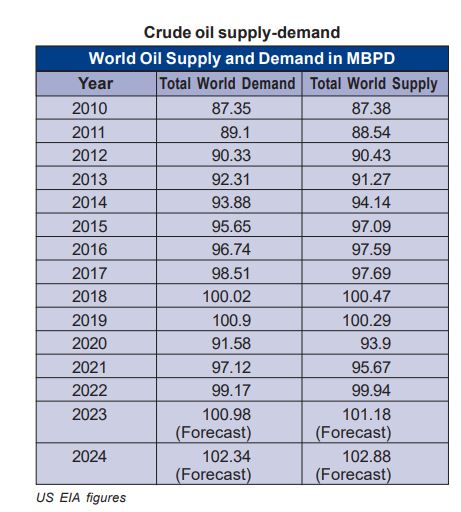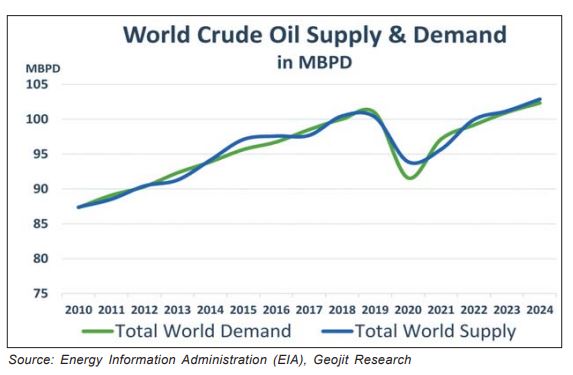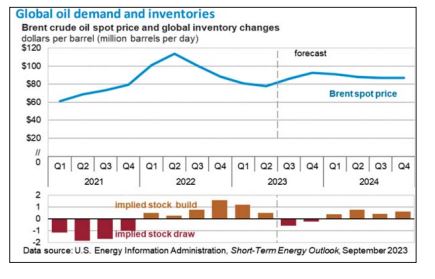Crude oil prices clocked at a ten-month high in September driven by worries about supply shortages after an unexpected extension of voluntary supply cuts by Saudi Arabia and Russia. Hopes of delay in further rate hikes by the US Federal Reserve and China demand optimism also aided the demand outlook.
The most active US WTI crude tested a high of $93.78 a barrel level, while the Asian benchmark Brent crude pushed above $95 a barrel, for the first time since November last year. A similar move was witnessed in the domestic futures market as well.
OPEC Plus extended its production cut till December
In April, the key oil-producing countries including Russia commonly known as OPEC Plus, announced a combined production cut, proposed to extend till 2024 aimed at supporting market stability. However, Saudi Arabia and Russia voluntarily introduced additional reductions in production on top of the broader deal by the OPEC plus countries.

Saudi announced a reduction of 1 million barrels of oil per day from July while Russia started cutting down daily production by 300,000 barrels daily. There were expectations in the market that both countries would extend the supply cut into October, but they surprised the market by extending the program till the end of December.
Both countries also informed that the plan would be reviewed monthly and adjusted according to market conditions. This has raised worries that demand will exceed supply in the coming quarter sending prices to multi-month highs.
As per the US EIA report global oil inventories may fall by 0.2 million barrels per day in the fourth quarter of 2023 based on the extension of this production cut.
China’s economic stimulus may boost demand outlook
Economic stimulus measures taken by the Chinese government to boost the country’s faltering economy are expected to raise the oil demand. China’s policymakers have taken stimulus measures like cutting rates and adding liquidity to the financial system to step up the economy.

The latest data from the country shows that crude oil imports in August surged by 30.9 percent from a year earlier as refiners built inventories and increased processing to benefit from higher profits from exporting fuel.
A private sector survey from the country shows that the government’s efforts have had some effect on its economy with improved factory activity, an increase in supply and domestic demand, and employment in August.
Earlier, there were concerns that the soft economic outcomes would eventually translate into weak oil imports and demand from the world’s largest importer and second-largest consumer of crude oil.
The US Federal Reserve decided to hit a pause on interest rate hikes
Oil prices also disregarded the pressure from a strong US dollar which is currently hovering above a six-month high. In its recent policy meeting, the US FOMC kept interest rates steady in a range of 5.25% to 5.5%, a 22-year high. The Federal Reserve, however, stiffened its hawkish stance, with a further rate increase projected by the end of the year, and monetary policy kept significantly tighter through 2024 than previously expected. Delaying rate hikes would buoy the economy and boost the demand for fuel.

Easing recession worries
The latest upbeat economic numbers from the US soothed investor worries about an imminent recession triggered by the aggressive rate hikes of the Federal Reserve. Besides, the European economy returned to growth as inflation continued to fall in the second quarter of 2023 raising firm demand outlook from the West.
US inventory levels running at their lowest level this year
Shrinking inventory levels in the US is another reason for pressurizing the supply outlook. The US crude oil storage levels recently plunged to a 40-year low. After the Ukraine war broke out, the US government used its Strategic Petroleum Reserve as its biggest buffer against global energy price volatility.
Last year, the country released 180 million barrels from the SPR to hedge against expensive oil prices and cool decades-high inflation. Record demand, producer supply cuts, and rising storage costs are the other reasons that point to increasing drawdowns.
While the US government has been planning to replenish the SPR, the number of barrels left in the reserve is currently less than half of the all-time highs reached in 2010.

However, the US EIA forecasts global liquid fuels production will increase by 1.2 million barrels per day in 2023 despite recent voluntary decreases in production from OPEC Plus. Non-OPEC production especially from the US, Brazil, Canada, and Guyana would be the main driver of global production growth as per the agency.
Prices remain choppy with mild positive bias
Looking ahead, though the tight supply outlook offers support to prices in the immediate run, other catalysts like worries over the global growth outlook and a firm US currency likely to halt major gains. On the price side, US WTI crude has stiff resistance at $102a barrel which needs to be cleared for further rallies. Otherwise, there are chances of a corrective selling but unlikely for major liquidation.







